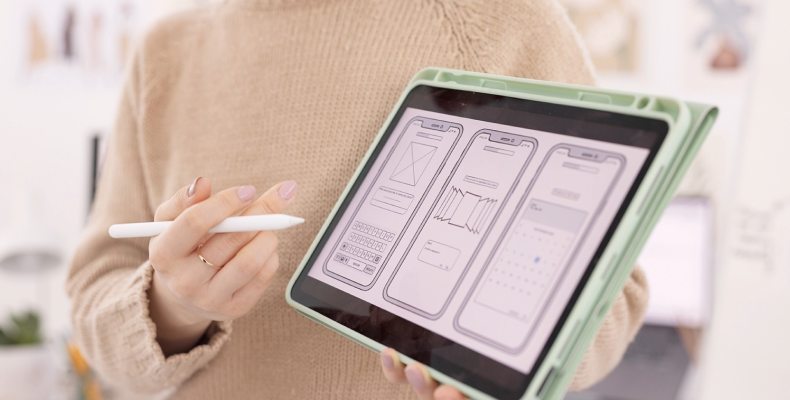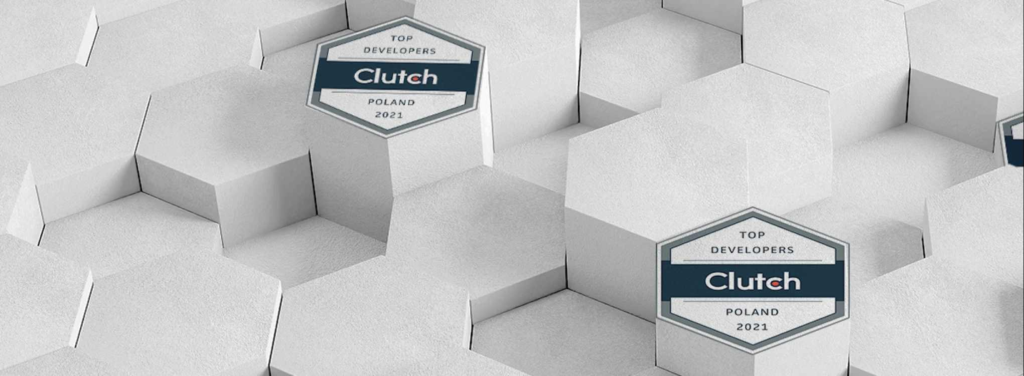We use cookies to ensure we give you the best experience on our website. By clicking Agree you accept our Privacy and Cookies Policy.
Digital product design: What is it and why you need it

Iryna Hnatiuk
Author

April 22, 2024
Date

 10 minutes read
10 minutes read
Content
When we talk about product design, we mean a significantly broad concept that is not only limited by appearance. We talk about usability, intuitiveness, and other factors that can be united under one characteristic — whether the product solves the user’s problem.
Close to 90% of users close and uninstall an application if it is inconvenient to use. That is, the likelihood of losing the audience due to poor design is very high. What is product design, its nuances, and the latest trends in this direction — we explore in this article.
What is digital product design?
Product design is the process of modelling, creating, and continuously refining a product to address the problems and requests of users. The process is highly complex, involving a detailed analysis of the target audience, the creation of user personas, and the examination of their requests and needs. It is also essential to monitor market developments and existing competitors. The latter is crucial not only for understanding what the competitors are doing but also for avoiding mistakes.
Moreover, product design makes businesses more profitable. A user-friendly and attractive application that aligns with market demands has significant potential for success and profitability.
Benefits and challenges
Among the main benefits of product design are:
User satisfaction: A well-designed product meets the needs and expectations of users. This, in turn, results in higher satisfaction. Skilled product designers create intuitive, enjoyable, and user-friendly solutions. This positive user experience often leads to increased customer loyalty and positive word-of-mouth.
Market competitiveness: Aesthetically pleasing and functional designs can set a product apart from its competitors. Additionally, focusing on innovation and unique features can create a competitive advantage, helping a product stand out in a crowded market.
Cost efficiency: Investing in thoughtful product design early in the development process can result in long-term cost savings. Addressing design flaws and optimising manufacturing processes in the initial stages helps prevent costly modifications later on. A well-designed product may require fewer repairs and have lower maintenance costs. This contributes to overall cost efficiency.
Three main challenges of product design include:
Balancing form and function: One of the primary challenges is finding the right balance between aesthetics and functionality. While a visually appealing design can attract customers, it must not compromise usability or performance. Striking this balance requires careful consideration of user needs, technical constraints, and design principles.
Changing technology landscape: The rapid pace of technological development creates small and big challenges. Keeping up with evolving technologies and ensuring that a product remains relevant requires continuous adaptation. Designers must stay informed about emerging technologies and be prepared to integrate them into their designs.
User diversity and inclusivity: Designing products that cater to diverse user demographics can be challenging. Products need to include various preferences, abilities, and cultural differences. Ensuring inclusivity in design means considering factors such as accessibility, cultural sensitivity, and usability for those with different physical and cognitive abilities.
This challenge highlights the importance of thorough user research to understand the diverse needs of the target audience.

Digital product design process
While different teams of digital product designers and organizations may have variations in their approaches, the following is a general framework for the design process:
Problem definition: Understand your target audience, competitors, and market trends. Conduct user interviews, and surveys, and analyze data to identify pain points and needs.
Clearly define the goals of the future digital product. What problems will it solve, and what values will provide?
User personas and user journeys: Create detailed user personas representing your target audience. Develop user journey maps to visualize the user’s experience from awareness to adoption.
Ideation: Organize brainstorming sessions to generate ideas. Use different techniques, including mind mapping, storyboarding, and design sprints.
Wireframing: Create low-fidelity wireframes to outline the basic structure and layout of the product. Focus on key functionalities and interactions.
Prototyping: Develop interactive prototypes to simulate user experience. Test it with potential users to collect feedback on usability and functionality.
Creating visual design: Design visual elements, including colors, typography, and imagery. Ensure consistency with brand guidelines and create a visually appealing interface.
User testing: Conduct usability testing with real users to identify any issues with the design or functionality. Gather feedback and make adjustments.
Development: Collaborate with developers to bring the design to life. Use agile methodology for an iterative and collaborative approach.
Testing and Quality Assurance: Perform rigorous testing to identify and fix bugs. Ensure the product meets quality standards and functions correctly on different devices and browsers.
Launch: Deploy the product, monitor performance, and address any issues that arise during the initial release.
Improvements: Use feedback and data to make iterative improvements. Continuously update and enhance the product based on user feedback and market changes.
What is the difference between product and UX design?
Scope:
Product Design: Encompasses the entire product, including its functionality, aesthetics, and business considerations.
UX Design: Focuses specifically on the user’s interaction with the product, ensuring a positive and seamless experience.
Goals:
Product Design: Aims to create a well-rounded product that meets business objectives, user needs, and market demands.
UX Design: Aims to enhance user satisfaction by improving the usability, accessibility, and overall delight in using the product.
Focus Areas:
Product Design: Involves strategic decision-making, market analysis, and collaboration with cross-functional teams.
UX Design: Concentrates on user research, information architecture, interaction design, and usability testing.
Responsibilities:
Product Design: Involves defining the overall product strategy, setting goals, and ensuring alignment with the company’s vision.
UX Design: Involves creating wireframes, prototypes, and conducting user testing to refine the user interface and overall experience.
Timeline:
Product Design: Spans the entire product development lifecycle, from conception and planning to release and post-launch iterations.
UX Design: Typically involves intensive work during the early stages of development, focusing on creating a solid foundation for the user experience.
Collaboration:
Product Design: Requires collaboration with various teams, including marketing, development, and business, to ensure a cohesive product strategy.
UX Design: Involves close collaboration with developers, visual designers, and other stakeholders to implement and refine the user interface.
Metrics:
Product Design: Success is often measured by overall business performance, market share, and revenue generation.
UX Design: Success is measured by user satisfaction, task success rates, and the overall quality of the user experience.
Iterations:
Product Design: Involves continuous iterations based on market feedback, business performance, and evolving strategies.
UX Design: Involves iterative design based on user testing and feedback loops to improve the usability and user satisfaction.

The role of design thinking in digital product design
Design thinking provides a structured and user-centric framework for the product design process. At its core, it has empathy, which encourages designers to understand the users’ needs and experiences. This understanding is crucial for problem definition, as design thinking means considering challenges users face when interacting with digital interfaces. Such a user-focused approach ensures that digital product meets functional requirements and resonates with its audience.
Design thinking also fosters a culture of ideation and creativity. Creative brainstorming is instrumental in the digital product design phase, pushing teams to think beyond conventional solutions. Design thinking helps designers visualize concepts quickly, ensuring that the final product aligns closely with user expectations and preferences.
In addition to impacting the creative process, design thinking promotes cross-functional collaboration. Bringing together designers, developers, marketers, and stakeholders, ensures a holistic approach to digital product development. This collaborative effort leverages diverse expertise, producing products that function well and align with business goals.
Top things to consider for a successful digital product design strategy
A successful digital product design strategy is based on a user-centric approach and understanding user needs. Begin by conducting thorough user research, creating personas, and mapping user journeys to inform design decisions. Define the core problem your product addresses, ensuring its relevance through market research and a keen awareness of competitors. Collaborate across functions to align design goals with business objectives, maintaining consistency in branding and prioritizing accessibility for a diverse user base.
Embrace an iterative design process, conducting regular usability testing to refine the user experience. Stay adaptable to emerging technology trends, implement robust security measures, and leverage analytics for data-driven insights. Regularly revisit and refine the strategy based on user feedback, technological advancements, and evolving market dynamics.
Product design tools that are worth using
There are numerous tools catering to different aspects of the design process. Their choice often depends on factors like team preferences, collaboration requirements, and specific design workflow needs. Here are three tools we recommend to use to design digital products:
Sketch
Sketch is a vector-based design tool primarily used for interface design, including web and mobile applications. Its key features include:
- Intuitive interface for designing user interfaces and interactive prototypes.
- Robust symbol and style management for efficient design consistency.
- Extensive plugin ecosystem for additional functionality and integrations.
- Excellent support for collaboration and version control through plugins like Abstract.
Figma
Figma enables real-time collaboration for digital product designers and design system maintenance. The key features of Figma are:
- Browser-based, allowing teams to collaborate simultaneously in real-time.
- Seamless transition from design to prototyping, fostering a cohesive design-to-development workflow.
- Robust design component and style system for building and maintaining design systems.
- Supports integrations with various third-party tools and plugins.
Adobe XD
Adobe XD is a design and prototyping tool for creating user experiences across different platforms. It comes with:
- Intuitive interface with a focus on speed and efficiency in design.
- Seamless integration with other Adobe Creative Cloud apps for a streamlined design workflow.
- Powerful prototyping capabilities for creating interactive and animated prototypes.
- Collaboration features that allow designers to share and gather feedback on designs.
Digital product design: Best trends in 2024
The field of digital product design is dynamic, and trends can evolve rapidly. Here are some that were the most prominent in the last year and are definitely here to stay:
Immersive experiences: Continued emphasis on immersive and interactive design, with increased use of augmented reality (AR) and virtual reality (VR) to enhance user experiences.
Sustainability in design: Increased attention to sustainable design practices, including eco-friendly UX, reduced energy consumption, and ethical considerations in product development.
Data visualization: Enhanced data visualization techniques make complex information more accessible and engaging for users, catering to the growing importance of data-driven decision-making.
Gesture-based navigation: Continued exploration of gesture-based interactions and navigation patterns, particularly in mobile and touch-based interfaces.
Personalization and AI: Increasing integration of artificial intelligence (I) to personalize user experiences, providing tailored content, recommendations, and interfaces based on user behavior and preferences.
Accessibility-first design: Intending to design digital products that prioritize accessibility from the outset, ensuring inclusivity and usability for users with diverse abilities.
Conclusion
Digital product design and development is a vibrant ecosystem where innovation thrives, and user experiences flourish. That’s why understanding the nuances of the design process is vital. From distinguishing between product and UX design to embracing design thinking and staying attuned to the latest market trends.
Digital product design with Blackthorn Vision
In the dynamic realm of product design, where creativity meets functionality, we’ve developed our own insights and build strategies. We’ve delved into the benefits, challenges, and pivotal role of design thinking. If you need a design partner to bring your product to the market or to a new level, look no further! Our digital product design and development team will gladly analyze your idea and offer you advice and services tailored to your needs.



















































































